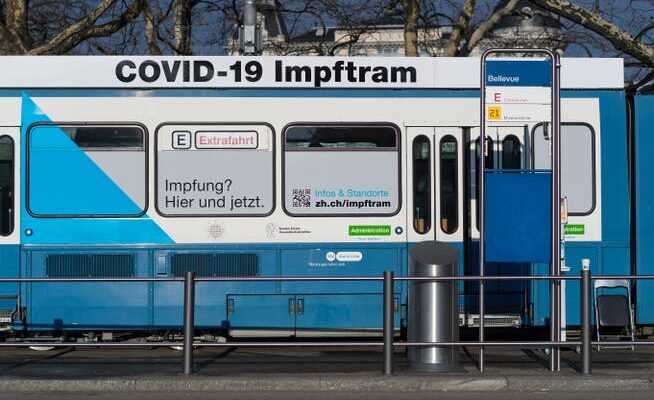The vaccination centers should not be dispensed with entirely. Boosters in particular are in demand, but so are initial vaccinations.
Has done its job: the Zurich vaccination tram is no longer returning to normal driving operations.
Switzerland is taking cautious steps toward post-pandemic normality. The most visible sign of the Covid-19 era, the mask, has largely disappeared from the public eye since April 1, but certain structures for dealing with the pandemic will remain in place for the time being.
Four vaccination centers are currently still open in the canton of Zurich, at Hirschengraben in Zurich city center, in Winterthur, in Oerlikon and in Uster. The latter two will temporarily cease operations at the end of April, as the health department has announced.
The other two operate on the back burner. The center in Winterthur, for example, is only open on Wednesdays from 2 p.m. to 8 p.m. and on Fridays from 1 p.m. to 6 p.m. At peak times, Winterthur was able to administer 2,500 vaccinations per day, but now a maximum of around 1,000 are still possible per half day.
But even that is overkill. With its 1000 vaccinations, the Winterthur center could currently meet the entire Zurich vaccination demand on its own.
Currently, between a good 500 and almost 900 vaccinations are administered throughout the canton every day, primarily boosters. This shows the latest Covid-19 bulletin from the Directorate of Health.
Although the vaccinations are also available in doctors’ surgeries and pharmacies, they don’t just twiddle their thumbs in the large vaccination centers. There is still a basic demand, says Thomas Kraft, the managing director of the Winterthur center. “Last Wednesday, for example, we administered around 270 vaccinations.”
The entire spectrum is vaccinated, from the first dose to the booster. Among those vaccinated are children, but also Ukrainian refugees.
“We are counting on the second booster vaccination”
Despite the relatively low occupancy rate, a closure of Winterthur is currently not an issue. “Then we would lose our staff and their expertise,” says Kraft. This would become a problem above all if Corona were to become more dangerous again in autumn. In this case, the canton wants to ramp up its capacities quickly, and that can only be done with people who know what needs to be done.
“We started with a vaccine, an age group and a dosage,” says Kraft. “But now vaccination has become much more complex.” There are multiple vaccines, multiple age groups, multiple dosages. There are those who already had Covid before the vaccination and people who are being given different vaccines.
“Rebuilding this expertise in the fall would be at least as expensive as running the center on a reduced basis during the transition period,” he says. In addition, the location is also a test center, and despite the return to normality, corona tests are still very important, for example for travel.
The center in Winterthur can draw on a staff pool of around 700 people. New people are currently not being sought, says Kraft. But that could change again in the fall. “We are counting on it,” he says, “that the second booster vaccination will then come.”
In such a case, the vaccination centers in Uster and Oerlikon could also be reactivated.
Contact tracing: only a core team remains
Another core element of the Zurich fight against corona, contact tracing, was discontinued at the beginning of April. This was reported by the Tamedia newspapers. The Corona hotline will remain in operation for the time being. In addition, those who tested positive would still receive an SMS to download a confirmation of the laboratory result.
Now a small core team of around two dozen people is to continue to be employed. Similar to the vaccination centers, a minimal structure should also be maintained for contact tracing, which can be ramped up quickly in the event of a new wave in autumn.
At the end of December, capacities with regard to the new Omikron variant had been greatly expanded; in January, up to 1,000 people were employed in contact tracing, working in a seven-day operation.
The vaccination tram is not coming to the museum
The vaccination tram has definitely reached its final destination. Perhaps the most unusual vaccination center in the canton of Zurich was launched last September. On March 31st it had its last use. The next stop is called Schrottplatz.
The vehicle, a “Tram 2000” type from the 1970s, is being phased out, says Daniela Tobler, spokeswoman for Zurich’s public transport company. There are also no plans to launch another vaccination tram in the fall. “The subject of the vaccination tram is over for the VBZ,” says Tobler.
There is not even room for the special model in the Zurich Tram Museum. It is firmly planned that a tram 2000 will be part of the collection, but not in the special configuration as a vaccination tram, says Markus Knecht, the president of the sponsoring association.
“We want to keep the vehicles in the same condition as they were in public transport at the time,” he says. “So we are looking for typical representatives of a tram and just not special versions.”
In the archive of the Tram Museum, however, the vaccination tram can be found. “We photographed and documented it extensively,” says Knecht. “It is easy to imagine that we will show the pictures as part of an exhibition about special trams, for example.”
